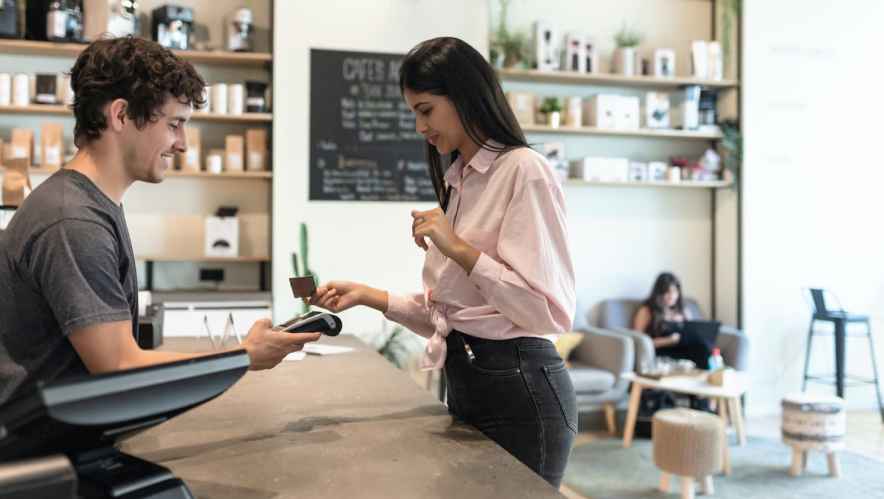If you’re like a lot of people, your morning doesn’t really start until you stop at your favorite coffee shop. You fumble around to find your customer loyalty punch card that gets you one purchase closer to a free drink. Or, maybe it’s managed through the shop’s app and you periodically check on your progress. Then, drink in hand, you’re ready for your day.
When most think of customer loyalty programs, these are the types of programs that come to mind. Earn your way to a free cup of coffee or a flight upgrade. Or, maybe you’ll get an “exclusive” discount. While many customers sign up for these programs and redeem their rewards, they’re not necessarily the drivers of repeat business. And, oftentimes, the perks aren’t enticing enough to keep customers interacting with the program (or company). Customer service, product consistency, and just plain habit may be stronger predictors of loyalty in these cases.
In today’s online world, it’s easier than ever for customers to switch products. Consumers are not as loyal to brands due to just convenience or necessity. The low (or non-existent) barriers to entry for new players make new options common. With COVID-19 making it more difficult for businesses to engage with customers, there has been a rapid shift toward digital engagement. Customers who embrace digital technology make it even easier to switch to them.
Customer expectations have soared as they expect a consistent, personalized experience from every interaction. And the payoff is big. Customers are willing to share their data with brands that are exceptional at meeting their individual needs. This makes keeping your customers loyal more important than ever. And, like many of the shifts in business, there are big shifts in how you need to think about customer loyalty.
Shifts in customer loyalty programs
Customer loyalty programs date back to 1793 when retailers gave customers copper tokens with their purchases that they would redeem for future purchases. Because the tokens were expensive, they started using stamps in 1896. These programs evolved through time from boxtops with coupons or rewards and prizes in cereal boxes to modern-day frequent flyer mile programs and loyalty cards that track purchases.
In 2009, Starbucks launched its mobile app that now includes its Starbucks Rewards loyalty program and ties earning additional stars to paying through the app. They made it simple and convenient for customers to track their progress toward rewards and make purchases. Customers quickly changed their paying habit making it the most regularly used loyalty program app. And, by adding personalized offers based on past purchases, it also drives additional sales.
With more purchase points and consumers engaging across many channels before deciding to buy, businesses need to find a way to consolidate customer share of spend and increase share of wallet. Brands are increasingly competing for customers’ mindshare and retention. Understanding how customers want to engage with loyalty programs is key to keeping competitors from pulling them away.
Experiential customer loyalty rewards
Loyalty programs offer a powerful vehicle to acquire customers and capture valuable customer insights. However, this rich data is not being effectively used to drive experiences based on true understanding of customer preferences, affinities, and behaviors to build an emotional connection with the brand. Analyzing the data is the key to building better loyalty programs that offer the level of personalized experiences customers expect.
As consumer expectations continue to evolve (and because they are very aware that they’re sharing their data with companies in exchange for personalized experiences), loyalty programs also need to change to adhere to these new expectations. To increase customer “stickiness,” companies need to expand their programs to provide better value and offerings. Instead of earning the same free cup of coffee after the tenth purchase that everyone gets, companies need to shift to experiential rewards. Some companies, including the Starbucks Rewards example above, are embracing this approach. A leading airline offers tickets to premier league soccer games based on the top-tier member preferences. Top retailers offer rewards including early online and in-person access to major sale events or opportunities for top-tier members to earn trips to major global events and special classes.
Expanding your loyalty strategy beyond ”earn-and-burn” and making it an enterprise-wide strategy is what helps to drive experiential programs. Many companies stick their customer loyalty management program with one department or even small teams within a department. This often limits the scope of the program, resulting in transactional experiences. A loyalty program shouldn’t be a siloed endeavor — it should span the entire business. Customers expect consistency across all interactions and touch points they have with companies, regardless of department or the reason for the interaction. Boosting internal adoption and engagement for today’s successful program requires buy-in and engagement from all areas of the company.
Also, developing a complementary partner ecosystem can expand the experience beyond the limits of a company’s own products. Consider what complementary products may provide more value and increase stickiness to the program. For example, a frequent flyer program could partner with popular restaurants so travelers can redeem their points for a meal in the city they’re visiting. That increases the engagement of the overall program.
With personalized, dynamic, frictionless experiential rewards, the goals are engagement and advocacy rather than just retention. Personalized rewards build emotional connections that transform customers into advocates. It’s what takes customers from getting their card punched to being truly delighted with an experience they can’t wait to tell their friends about.
Reimagining the customer loyalty experience
Creating the type of experience customers now demand takes more than an evolution. It’s time to completely reimagine what the loyalty experience needs to be.
Companies need to address and remove organizational silos that inhibit customer experiences. Are your marketing, commerce, and customer service teams taking advantage of rich loyalty insights to deliver a coherent and consistent customer experience? Or are there business, cultural, or technology blockers inhibiting the ability to drive a consistent member experience?
Providing the right technology and tools is key for success. Gone are the days of paying for highly-customized programs that take years to deploy and are outdated before launching. Integrated loyalty ecosystems enable personalized, connected experiences that can connect the dots throughout the customer journey to deliver on the brand promise across every customer touch point.
Next generation loyalty programs are all about driving highly personalized, contextual, and dynamic experiences. And creating this kind of experiential loyalty program requires brands to harness data and leverage it across every customer interaction. Companies can glean powerful insights about customer affinities and preferences from the digital footprints of customer interactions and then put them to work.
Embedding loyalty insights – powered by metrics and analytics – that are available to all employees and driving business processes influenced by loyalty can lead to holistic and differentiated experiences delivered by everyone across the customer journey spectrum. An end-to-end loyalty platform empowers businesses to create intelligent, differentiated experiential engagements that grow relationships and increase customer lifetime value.
Aligning B2B and B2C loyalty programs
While customer loyalty programs are more common for B2C companies, B2B companies are adopting programs as they realize the value it brings. B2B loyalty programs can better engage partner and distributor channels with incentives that will improve performance and foster long term relationships. It also helps them align their channel partner initiatives with end-consumer initiatives, which is a must.
Beyond driving economic value from increased purchases, B2B companies can use loyalty programs to increase both stakeholder and brand value by including rewards that bring long-term value for both. For example, setting up a program in which the partner earns points for additional product training, providing feedback, and engaging with the program. The points earned could unlock co-marketing funds to drive even more sales or “exclusive” training to help them sell better. Or, as customer interest in purchasing from companies who support corporate citizenship continues to grow, point redemptions could go toward a cause or local community development.
What’s next?
Earning a customer’s loyalty is both valuable and important. Effective customer loyalty programs require putting the customer experience at the center of your program and delivering personalization at scale. Salesforce Loyalty Management gives access to tools companies need to create the experiences that can help increase customer engagement and value.
Learn more about customer loyalty programs
See how Loyalty Management can help your business engage customers in meaningful ways to bring more value to their experience.































